This article covers the 2009 through 2012 Seasons.
Click the following links for additional seasons:
2009
Note: All the inadvertent references to “I” in this section refer to Jim. The garden is a mutual effort. Charlotte primarily manages the flowers and Jim oversees everything else. Both Charlotte and Jim pick harvest and prepare the bounty for storage. These first photos were taken in August 2009, the first harvest year for our garden. We were still working to get our soil right, but were very satisfied with the results. In general don’t expect too much that first year. It takes a while to get the soil to the proper balance. We used top soil from Sand Mountain mixed with processed cow manure and humus.
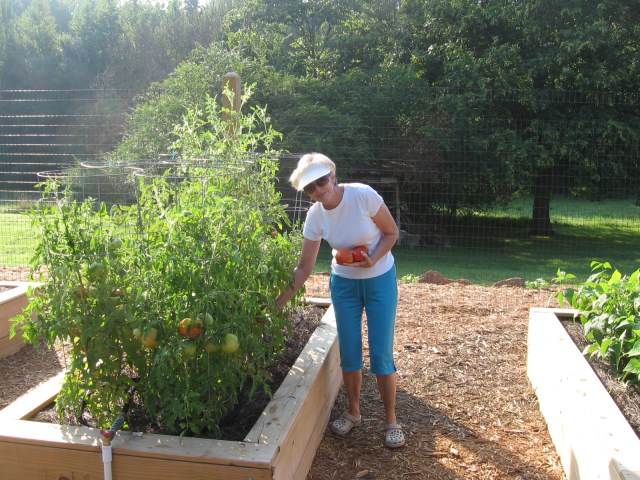
Charlotte harvests Parks Whopper tomatoes. They really produced that first year of our garden. This photo was taken on August 13, 2009. In the background you can see chestnut trees. We have three very mature trees which the squirrels and deer really love to visit in the fall when the chestnuts cover the ground. The prickly outside doesn’t bother the deer in the least and they will often visit several times per day during the peak harvest time.
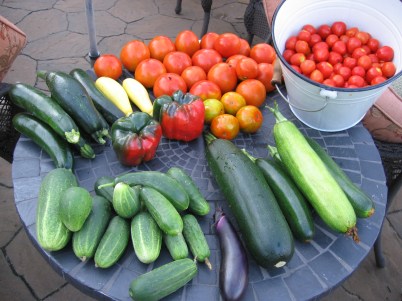
The result of one day’s harvest … zucchini squash, yellow straight neck squash, Parks Whopper tomatoes, Parks Tomatoberry tomatoes, red bell peppers, orange eggplant, Ichibahn eggplant.
This is what it is all about. We don’t have a huge garden. We are more interested in quality than quantity. That is the reason we grow organically. We will sometimes try new things like the orange eggplant shown in this picture. We had never seen one before. Our friend Les Rivett who along with her husband Jay own Jay’s Variety Garden near Hennegar, AL gave us the plants. It was so much fun to grow and added a significant new variety to our garden. We especially enjoyed the bright orange color. The longer you left them on the vine, the deeper the orange color would become. The black/purple Ichibahn eggplant was also an interesting and heavy producing plant. We never had much eggplant over the years and frankly about the only way we knew to prepare them was to order them when we dined at our favorite Italian restaurant, Provinos, in the form of a Chicken and Eggplant dish. There was so much sauce on that dish that I’m not sure you could taste the eggplant! We are still learning to store and cook multiple varieties of eggplant.
2010
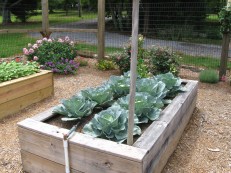
We have room for 8-9 cabbages in one bed. They grow well in cooler weather. Here they are maturing in early June, 2010. Believe me, these taste so much better than those you can purchase at your local supermarket.

We plant radishes along the side of the bed early in the spring as they mature in about 30 days. Here they are planted in a squash bed. The radish greens are good in a mixed green salad. We have also cooked them like you would turnip greens, mustard greens or collards.
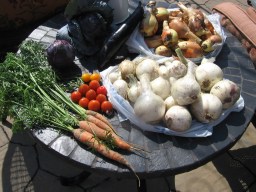
White and yellow onions along with carrots along with Tomatoberry and yellow salad tomatoes, purple cabbage and an Ichibahn eggplant. Photo taken 06-16-2010
…You don’t need a lot of space to successfully grow these veggies. I planted the onions in late fall of 2009 and they over-wintered very well and matured in early June. The carrots and purple cabbage were planted in late February 2010. Carrots are difficult to grow in our garden when the temperatures start to rise. We were successful with these but had difficulty in later years.
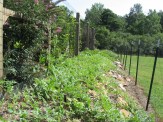
We grow watermelons and cantaloupes on the backside of the garden space on the back walkway above the herbs.
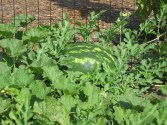
This watermelon variety (sugarbaby) grows to a size of 6-8 pounds … perfect for our size garden. But beware, the vines still need a lot of space to spread out and are not suitable for the boxes in our raised bed garden.

These are thornless blackberries. This is the first year they were planted and the vines are very small. Nevertheless, they produced enough berries for us to enjoy them several times … with no briars and no chiggers. One thing to be aware of is that they will expand their domain rapidly and are very difficult to contain.

Apache thornless blackberries on the vine. Photo taken 07-22-2012. This particular variety was developed at University of Arkansas and easily reaches to 6-7 feet in the second year.
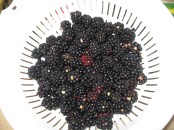
The finished product! Blackberries are a biennial plant. The first year they produce a stalk. The second year the stalk produces the berry and that stalk will die and new ones will replace them. That way you always have berries and empty stalks at the same time.

This is the way our Mountain House Kitchen looked almost every other day for a few weeks. The color coordination between the fruits of the harvest and the kitchen necessities is no accident. Charlotte thought about this well in advance of the development of the garden. You can get to the point where you say to yourself … “I wish that the garden would quit producing … I am tired and need to rest!!”
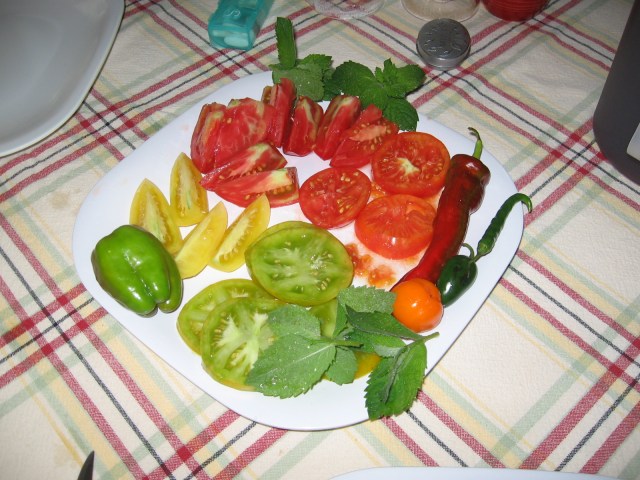
All from our garden … a plate from which we could prepare our salads. Note the mint is now producing. Just like the blackberries, it is difficult to contain the mint in the space you want to allocate to it.
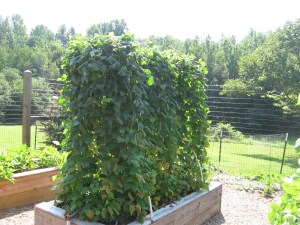
Kentucky Wonder pole beans. We used round metal bean towers purchased from Parks Seed to make the best use of our small space. They worked great.
The Kitchen at Harvest Time
As we were still learning what would do well in our environment in 2010 we planted these Kentucky Wonder Pole Beans. I had planted them in my gardens some forty years earlier and they were prolific and tasted great. A friend, C. G. Danner told us about another pole bean variety that he thought was even better that he was successfully growing. In 2011 we were determined to plant those “Rattlesnake” pole beans though we must admit that we were a little afraid of the name.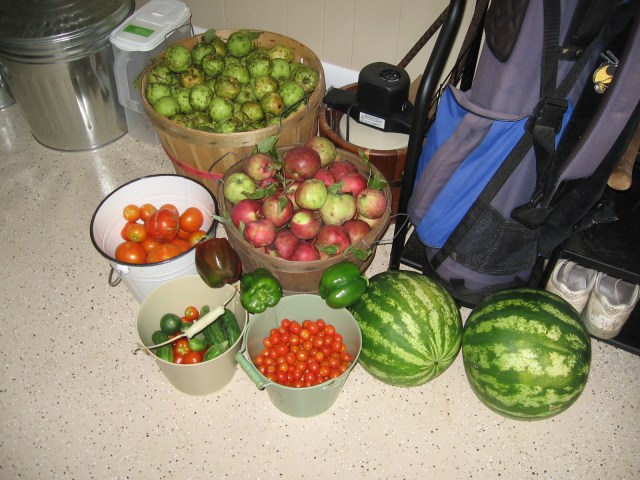
Fruits of the garden we took back to our friends in the Atlanta area. The apples came from trees planted by my father in the late 1970’s. The red apple tree was damaged beyond repair by a wind storm in 2011 and we had to take it down. What a disappointment! There are plans to expand the “orchard” and add more fruit trees in the future.
Greens such as spinach, collards, mustard, and turnips grow well in our raised beds. You must plant them in late winter/early spring or in the fall on Lookout Mountain. They just can’t take the hot July and August days. They are easy to plant and easy to care for and freeze really well.
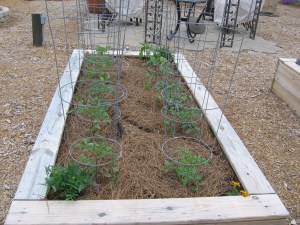
The first couple of years we had the garden I planted tomatoes ten plants to a box. It worked out that was too many for space. I am now (2012) planting no more than six per box. While ten produced okay, they shade each other out and don’t get enough water and nutrients to do their best. I had to overcome the tendency to over-plant in the smaller spaces.
The first couple of years we had the garden I planted tomatoes ten plants to a box. It worked out that was too many for space. I am now (2012) planting no more than six per box. While ten produced okay, they shade each other out and don’t get enough water and nutrients to do their best. I had to overcome the tendency to over-plant in the smaller spaces.
.
.
.
.
.
2011
This section of the “Fruits of the Garden” is under development.
xxx
xxx
xxx
2012
In the 2012 gardening season we tried some new varieties in our raised beds. The winter was fairly mild and ended early. Two varieties of potatoes, norland reds and yukon gold, were planted on February 23, 2012 and harvested at the end of June allowing for the replanting of some better boy tomatoes for late season harvesting. This worked well and we determined that we like the norland reds the best as they keep the longest and in 2013 we will plant a full bed of them instead half norland and half yukon. We cut some of the yukons into 1/2 inch pieces, blanched them and then froze them. We are still eating them in the late winter of 2013. The white and yellow onions, radishes, lettuces and summer squash really did well this season due to the early and mild spring. Most of the garden was fully planted with summer vegetables by April 23.
x
.
.
.
.
.
.
.
.
.
.
.
.
This short video gives you a good perspective of the 2012 garden in June. Plants are vibrant at this time and insects haven’t had time to do significant damage.
.
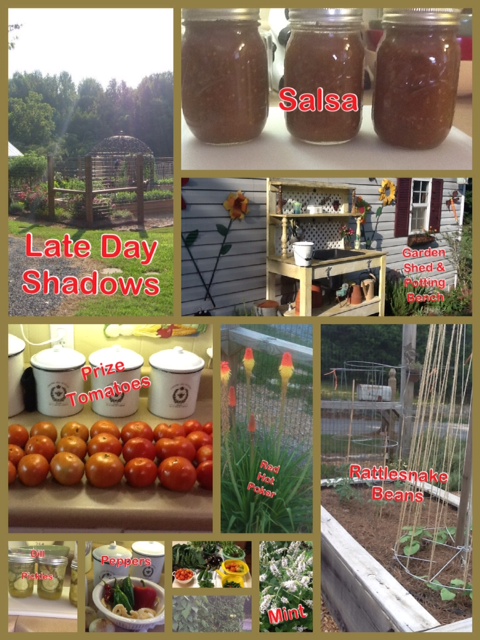 One of the joys of the garden is preserving some of the bounty for the winter season. This year we made more salsa using tomatoes, peppers and onions from our garden. Our extended family loved the salsa at our summer and Christmas gatherings. The rattlesnake pole beans are our favorite bean. We have tried several varieties and these are well adapted to raised beds. They bloom abundantly, mature quickly and remain tender on the vine for a long period of time. We grow several varieties of mint and enjoy it in our water and tea all summer. The aroma of the mint fills the garden air and is really pleasant to the tongue. This year’s cucumber crop did not do very well. Last years harvest was superb. But we did manage to make a reasonable number of jars of dill, kosher and bread & butter pickles for the winter. We grew several varieties of peppers including poblano, anaheim, jalepeno and cayenne. One bed was devoted to the peppers and it paid off as we were able to make many quarts of pepper relish to use on our vegetables and meats in the fall and winter months. Jim concocted his own recipe that he dubbed as “Jim’s Super Pepper Relish.” When I shared this relish at our Christmas family gathering everyone that tried it really liked it. Here’s a link to read an article I wrote about Jim’s Super Pepper Relish and some other thoughts at the end of the 2012 gardening season.
One of the joys of the garden is preserving some of the bounty for the winter season. This year we made more salsa using tomatoes, peppers and onions from our garden. Our extended family loved the salsa at our summer and Christmas gatherings. The rattlesnake pole beans are our favorite bean. We have tried several varieties and these are well adapted to raised beds. They bloom abundantly, mature quickly and remain tender on the vine for a long period of time. We grow several varieties of mint and enjoy it in our water and tea all summer. The aroma of the mint fills the garden air and is really pleasant to the tongue. This year’s cucumber crop did not do very well. Last years harvest was superb. But we did manage to make a reasonable number of jars of dill, kosher and bread & butter pickles for the winter. We grew several varieties of peppers including poblano, anaheim, jalepeno and cayenne. One bed was devoted to the peppers and it paid off as we were able to make many quarts of pepper relish to use on our vegetables and meats in the fall and winter months. Jim concocted his own recipe that he dubbed as “Jim’s Super Pepper Relish.” When I shared this relish at our Christmas family gathering everyone that tried it really liked it. Here’s a link to read an article I wrote about Jim’s Super Pepper Relish and some other thoughts at the end of the 2012 gardening season.
The strawberry, blueberry and blackberry harvest really improved in 2012. There were enough strawberries for Charlotte to make to make jam and was wonderful on a hot buttered biscuit on a cold winter morning. The blackberries were abundant and as big or bigger than your thumb. Charlotte made several batches of blackberry jam. It is wonderful. We also froze many of them for later use. The blueberry plants are still in the process of maturing but there were several nice harvests like the one shown above making breakfast a special time. Some mornings Jim ate all three along with his breakfast!
The ever-bearing strawberries produced into November. Jim stood and ate them by the hand full each time he visited the garden. One of the fun things we shared with friends was the size of some of our tomatoes. Some were actually larger than cantaloupes … but the joke is that while the tomatoes were large, the cantaloupes were relatively small … more of a personal size suitable for one or two people. I can’t convey in words how sweet the sugar baby watermelons were. In previous years we had planted them on the backside of the garden where they were protected only by deer netting. After a couple of break-ins by the deer and the stomping of several watermelons I learned that I had to grow the watermelons on the inside of our 7 1/2 fenced area. It was actually kind of fun to watch the vines grow and wind their way around the raised bed boxes. Each vine produced 3-4 melons. The eggplants were abundant in 2012. After we learned a great way to cook them they became one of our favorites, especially when we cooked steak on the grill. We would slice the eggplant into about 1/4 inch slices, salt them and let them “weep” their captured water for about 30 minutes. Then we would pour off the water, wash off some of the salt and soak them in a mixture of olive oil and herbs. After grilling them on each side for 4-5 minutes, letting them get brown, they were ready to eat. Try it, you will like it … guaranteed.
.
.
.
.
.
.
.
.
.
.
.
.
.
We have two varieties of figs – an indigo and the good old standby brown turkey. The indigo is black and firm and very sweet. The tree is fairly small making it good for a small garden as it spreads only to 7 feet wide and 7 feet tall. It takes the fruit a while to ripen, but when it does … what a treat! The brown turkey fig tree needs more room with a 15×15 foot requirement. Our tree has only reached about 8×8 feet and produced so heavily that we couldn’t use all of the fruit it produced even after making several good sized batches of fig preserves. My wife’s brother loves fig preserves so we have a built-in avenue for sharing them. In the picture above the indigo and brown turkey figs are mixed to show the contrast between the two varieties.
Our muscadine (vitis rotundifolia) grapes are just beginning to produce enough to have a little more than we can eat. We have two varieties of muscadines … a deep purple one, almost black, and an almost bronze one generally referred to as a scuppernong. The muscadine is native to the southeastern United States and has been cultivated since the 1600’s. It is a tough skin grape able to withstand the hot summers of the south. The cultivated varieties have been used to make wine for centuries. Other products produced from muscadines include jelly, preserves, syrup, and sauce. One of our dear friends makes the sauce and take my word for it, it is wonderful. Given the right conditions, the vines will begin to produce heavily in the 3-5 year time frame. Ours were only in their second season. We await season three with great anticipation.
Below is a snap of our late season harvest on 09/30/2012. The collards were planted in mid-August. There were a few burpless cucumbers, but the hot sun scorched the plants and kept them from producing like the normally do in the early spring. Peppers are abundant at this time of year and the tomatoes are beginning to wane.

2012-09-30 Late Season Harvest: L to R, front to back – Tomatoberry Tomatoes, Mint, Jalapeno Peppers, Cucumbers, Georgia Collards, Eggplant, Early Girl (late) Tomatoes, Pablano Ancho Peppers, Anaheim Peppers, Sweet Baby James Watermelons.
2013
We began the 2013 planting season on February 23. We had a few nice days and the raised beds had drained well from the heavy rains and a few relatively light snowfalls that had taken place over the December-February time-frame. So the adventurous soul that Jim is and with the success of early planting in 2012 still in mind, a bright sunshiny day or two beckoned him to try his luck again.
Several varieties of lettuce such as romaine, butter crunch and red lettuce were planted in a bed with 8 Georgia collard plants. Yellow and purple onions and garlic were planted in another bed.
The Red Norland potatoes that did so well last year were planted in another full bed. Since the weather has not been as cooperative this year (as of March 25, 2013), with snow and many cold and below freezing days since planting, we may not be as fortunate as we were last year. We will soon know what has survived and what God has returned to the soil for the future.
 This may be the year that we use the PVC piping and row covers over the beds to ward off a late frost. To the left is approximately what the bed will look like covered. The material that is placed over the hoops lets the sun shine and rain through but encourages the warming of the soil and protects from even a heavy frost. The picture is for a large raised bed just above ground level. The picture on the right side was taken in 2009 when we were constructing the garden. When we built our 20″ high beds we bored holes on each side of the bed to allow us to install the PVC piping as needed. Initially I placed deer netting over the hoops because the fencing was not yet installed and we had no protection from four legged predators. We already have the piping and the mesh on hand and I am anxious to give it a try for the purpose that it was originally intended. No, the hoops will not be that high this time! I’ll provide an update later.
This may be the year that we use the PVC piping and row covers over the beds to ward off a late frost. To the left is approximately what the bed will look like covered. The material that is placed over the hoops lets the sun shine and rain through but encourages the warming of the soil and protects from even a heavy frost. The picture is for a large raised bed just above ground level. The picture on the right side was taken in 2009 when we were constructing the garden. When we built our 20″ high beds we bored holes on each side of the bed to allow us to install the PVC piping as needed. Initially I placed deer netting over the hoops because the fencing was not yet installed and we had no protection from four legged predators. We already have the piping and the mesh on hand and I am anxious to give it a try for the purpose that it was originally intended. No, the hoops will not be that high this time! I’ll provide an update later.
Updated as of 2013-05-22 – Well it is now late May and the garden is in full swing. The row cover worked fairly well as it provided protection from the rather cold weather that was experienced in April. Most of the seeds in the starter seed bed came up with the exception of the tomatoes. The ground was just too cold for the tomatoes. The cucumbers and zucchini prospered and have been transplanted. The sunflowers had no problem at all in the seed bed. They have mostly been transplanted throughout the garden and will be beautiful later in the summer. Some of them are 8-24″ tall, some are of medium height at 60″, and the tallest will reach 72-80″. The Norland Red Potatoes planted on February 23 are doing very well and I have “hilled” them by adding soil at their base to allow more underground room for the potatoes to expand as they grow. The strawberries and thornless blackberries are in full bloom and I have already eaten come of the strawberries. The blackberries will begin to mature in late June into the month of July. The onions and garlic are just beginning to head. Yellow squash was planted from seed last week and should be pushing through the soil later this week. Two versions of pole beans have been planted … our favorites are called Rattlesnake and the second variety we have dubbed “Uncle Frank’s Beans” for my uncle Frank Hixon who is thought to have planted these for many years beginning around 1935.
Here are a couple of collages of the vegetables at this stage of development.
Updated as of 2013-06-03
Today was the first canning day of our season. Strawberries are in abundance. We have devoted one box to them. Most are ever-bearing and will have fruit until frost in the fall … but the most abundant harvest is in late spring. Here’s a collage of today’s Strawberry Jam effort.
 This year we have again planted Rattlesnake Pole Beans and our Uncle Frank’s Heritage Pole Beans. We use Bean Towers to conserve space. This year we added a new bed that is a little closer to the ground as I was having trouble reaching the tops of the bean towers with the 20 inch beds. The thornless blackberry plant is some twenty-five feet from the mother plant that sent out this runner. The blackberry plants produce like crazy, but they are hard to contain … just like in the wild. In front of the blackberry plant are three small sunflowers that will reach a height of 24 inches and four cilantro plants that we cut as we use along with fresh tomatoes, onions and avocados to make a tasty afternoon guacamole treat.
This year we have again planted Rattlesnake Pole Beans and our Uncle Frank’s Heritage Pole Beans. We use Bean Towers to conserve space. This year we added a new bed that is a little closer to the ground as I was having trouble reaching the tops of the bean towers with the 20 inch beds. The thornless blackberry plant is some twenty-five feet from the mother plant that sent out this runner. The blackberry plants produce like crazy, but they are hard to contain … just like in the wild. In front of the blackberry plant are three small sunflowers that will reach a height of 24 inches and four cilantro plants that we cut as we use along with fresh tomatoes, onions and avocados to make a tasty afternoon guacamole treat.
Updated as of 2013-06-09
Red Norland Potatoes were planted this year on February 23, 2013, a day when the high temperature was in the forties (F) and the clouds were hanging low. These beauties were harvested on June 9, 2013 as a test. Most are of perfect size, but I will wait just a bit longer to harvest the remainder of this box.
Wikipedia relates: “Red Norland is a red, early-maturing potato. Smaller tubers (B and C size) are commonly sold as “baby reds” and this variety is often served boiled or in potato salads. The progenitor variety, Norland, was released by the North Dakota Agricultural College in 1957. Since the release of Norland, other darker red skinned variants were selected, most notably Red Norland and Dark Red Norland. None of these three varieties are under plant variety protection. The darker red strains are now widely grown, and Norland is rarely grown. Norland and its selections are widely adapted, but have relatively low to intermediate yields.”
Updated as of 2013-06-10
Today was a jelly making day. I remember as a child going blackberry picking with my Mother. She would locate the wildest and meanest looking blackberry patches and we would load the car with pails and buckets and head off to her find. It seems like my Mom always picked 2-3 times what I did. The fear of briars, chiggers and ticks weighed heavily on a little boy that would rather be somewhere else playing. Nevertheless, our trips were usually successful and Mom turned the blackberries into jelly and cobblers. Blackberry jelly was my favorite over peach and strawberry. I never really liked apple jelly as I thought it did not have enough flavor. Grape was okay, but if there was blackberry available it won every time, hands down! So when we planned our garden blackberry vines were on my list.
I chose the Apache Thornless and they have produced like crazy. Gurney’s Seed and Nursery describes them this way: “Jumbo-sized fruits with jumbo-sized flavor! Extra-fertile flowers, so you get more berries that are perfectly formed. Canes stand erect and are thornless. Ripens mid to late June.”
Okay, I know it is early June, so how did I make blackberry jelly when the berries haven’s ripened yet in 2013? The answer is I flash froze the berries whole last year that we did not use and pulled them out of the freezer some 11 months later. These berries tolerate freezing very well, but I would recommend that you don’t wait a year to process them like I did. I wanted to make sure there was room in the freezer for this year’s haul that will start maturing late June and well into July at our Lookout Mountain location.
Updated as of 2013-08-22
Today it is raining … again! This has been the wettest summer I can ever recall in my nearly seventy years of earthly existence. The unusual amount of rain and the frequency of it has the entire south saturated. Even on Lookout Mountain the Little River continues to roar over the falls and produce great downstream rapids for the kayak enthusiasts. The rain has promoted a lot of disease … especially fungus … and caused many of the plantings to produce less than normal results. Nevertheless, God has provided more than enough of His rich bounty to keep us busy drying, canning and freezing for the winter.
Since my last post we dried purple and yellow onions along with an ample supply of garlic. These were planted on February 23 and while they are smaller than usual the taste is superior. We will be able to use them well into fall and early winter. The onions, red potatoes and garlic combined with a bit of butter and French Provence (herbs of Provence) make up one of our most flavorful and favorite dishes that fit right into a healthy eating plan.
This year our Santa Rosa Plums produced heavily. The limbs were so loaded that some of them broke. This is the fourth year for the little tree and I am amazed at the abundant crop. The plums were large and tart and very easy with which to deal. They made wonderful Plum Jam that will last for well over a year and make nice gifts to our family. It took a whole day to turn the fruit into jam but the effort was most certainly worth it.
We also have another variety of plum that matures about three weeks after the Santa Rosa. The tree is more upright and the plums are generally smaller. With those we tried something new and made Pickled Plums, somewhat like you would Pickled Peaches. We didn’t quite get the recipe just right, so they are extremely tart … not something that everyone would like. But spending another whole day on them will most surely convince me to keep them on my menu during the winter season. After all, plums are low in calories and very satisfying to the tummy.
This was a great year for cucumbers. Last year was a bust. The vines were lush and produced heavily.
Here is a photo of the first ones of the season from which we made Dill Pickles. We also made Bread and Butter Pickles and Sweet Pickles. Our son and granddaughter love dills so we made plenty to share with them. My favorites are also the Dill … with a hint of hot red Cayenne Pepper … same basic mix … just add the whole pepper. It also makes the jar of pickles colorful. We still have a few jars of Kosher Dills from last year that will soon be consumed.
In late July we were able to accumulate enough tomatoes to make some Tomato Ketchup. This is different from salsa by a long shot. You have to cook the tomatoes down to a thick, almost pasty consistency. In this particular formula we used a mixture of Red Horizon and Better Boy tomatoes, purple onions, bell pepper and garlic along with vinegar, salt and Splenda. The resulting Ketchup tasted really good and since it did not make much for all of the effort, I am saving it for a very special occasion. Some folks may not like the mild bell pepper that was included.
A couple of weeks later we made thick Tomato Salsa with primarily Red Horizon tomatoes, a blend of spices and Jalapeno peppers for medium heat. I love to eat the Salsa with Blue Corn Tortilla chips. Mexican food is one of my favorites and we have to “eat Mexican” about once per week. We usually take home about half of what we order so we can have leftovers for lunch. That’s when the salsa really comes in handy. The salsa is also good with beef, pork and chicken.
We made “Jim’s Sweet Veggie Relish” during June. It consists of yellow and zucchini squash, yellow and purple onions, Anaheim peppers, carrots and herbs of Provence. The vegetables were prepared with a manual food chopper that cuts them into little cubes. The cubes make the resulting relish visually attractive both in the jar and on the plate. We just keep it in the refrigerator after opening and spoon it on peas and butter beans. It is also excellent with beef, chicken and pork in particular. This batch is lightly sweetened with Splenda … perfect for a low-fat, low-calorie diet.
Our Brown Turkey figs are producing heavily this year. The first ones were picked on August 21. In the past we have made fig preserves. We still have some of those left from last year. So this year we are trying a new approach to preserving them. The figs were cut in half and cooked in water with cinnamon, a small amount of light brown sugar and Splenda … similar to what you would do when making applesauce. Of course, you don’t want to mash the figs. Our green apple tree had very few apples this year but we harvested enough to process them at the same time as we did the figs.
The apples were cored and peeled with a neat manual apple peeler that we purchased on Amazon last year. This really saves a lot of time and a lot of labor and makes the job “doable.” After you use this peeler you will never again want to peel apples manually. The device will also peel potatoes and optionally cut them into spirals.
The muscadines and scuppernongs will soon be ripening. We planted one vine of each variety two years ago and planted two more this year. The vines have plenty of grapes now … more than we can eat. We are not into wine making … just grape eating, and perhaps some jelly and preserves! I will update the photos when they reach maturity.
We also have another table grape vine that on our property that dates back to the 1930’s. I published an article on July 19, 2013 about the history of the “Spindly Grape Vine” and invite you to follow the link to read it. The vine was originally planted by my paternal great grandfather, George Washington Crowe, discussed the explanation of the History Behind the Garden Plot.
The grapes are sweet and great to eat as a snack. I love to drop by the vine several times a day and pick a handful. The skins are so sweet. You eat them by stuffing three to four in your mouth at one time and then swizzling them around with your tongue and teeth to remove the skin, bite down on it to get the burst of sweetness and release the inner grape. You then spit out the skin and suck out the seeds which you also spit out, swallow the remaining pulp and move on to the next one … just like when I was a twelve year old boy roaming the property with my cousins during the summer visit. I dreamed about these grapes for years and now have them as my own.
*** End of 2013-08-22 Update ***
___________________________________________________________
Description of these photos will follow on next update.
.
.

2013 Norland Red Potatoes – second crop almost ready for harvest in early August
Photo by Jim Davenport
.
.
.
.
.

2013 Little Baby Flower Watermelon – on the vine with flower
I did not take this photo … here’s the source: http://www.watchmyfoodgrow.com/backyard-garden/watermelon-grow-raised-vegetable-garden/
.
.

2013 Sugar Baby Watermelon – 2013-08-26
This one is about one pound. Can’t wait to give it a try!
Photo by Jim Davenport
___________________________________________________________
.______________________________________________________________
Navigation Links to other articles about Jim & Charlotte’s Garden:
- Jim & Charlotte’s Garden – Introduction
- Background
- History Behind the Garden Plot
- Garden Construction
- Flowers of the Garden
- Live Garden Cam
2013
We began the 2013 planting season on February 23. We had a few nice days and the raised beds had drained well from the heavy rains and a few relatively light snowfalls that had taken place over the December-February time-frame. So the adventurous soul that Jim is and with the success of early planting in 2012 still in mind, a bright sunshiny day or two beckoned him to try his luck again.
Several varieties of lettuce such as romaine, butter crunch and red lettuce were planted in a bed with 8 Georgia collard plants. Yellow and purple onions and garlic were planted in another bed.
The Red Norland potatoes that did so well last year were planted in another full bed. Since the weather has not been as cooperative this year (as of March 25, 2013), with snow and many cold and below freezing days since planting, we may not be as fortunate as we were last year. We will soon know what has survived and what God has returned to the soil for the future.
 This may be the year that we use the PVC piping and row covers over the beds to ward off a late frost. To the left is approximately what the bed will look like covered. The material that is placed over the hoops lets the sun shine and rain through but encourages the warming of the soil and protects from even a heavy frost. The picture is for a large raised bed just above ground level. The picture on the right side was taken in 2009 when we were constructing the garden. When we built our 20″ high beds we bored holes on each side of the bed to allow us to install the PVC piping as needed. Initially I placed deer netting over the hoops because the fencing was not yet installed and we had no protection from four legged predators. We already have the piping and the mesh on hand and I am anxious to give it a try for the purpose that it was originally intended. No, the hoops will not be that high this time! I’ll provide an update later.
This may be the year that we use the PVC piping and row covers over the beds to ward off a late frost. To the left is approximately what the bed will look like covered. The material that is placed over the hoops lets the sun shine and rain through but encourages the warming of the soil and protects from even a heavy frost. The picture is for a large raised bed just above ground level. The picture on the right side was taken in 2009 when we were constructing the garden. When we built our 20″ high beds we bored holes on each side of the bed to allow us to install the PVC piping as needed. Initially I placed deer netting over the hoops because the fencing was not yet installed and we had no protection from four legged predators. We already have the piping and the mesh on hand and I am anxious to give it a try for the purpose that it was originally intended. No, the hoops will not be that high this time! I’ll provide an update later.
Updated as of 2013-05-22 – Well it is now late May and the garden is in full swing. The row cover worked fairly well as it provided protection from the rather cold weather that was experienced in April. Most of the seeds in the starter seed bed came up with the exception of the tomatoes. The ground was just too cold for the tomatoes. The cucumbers and zucchini prospered and have been transplanted. The sunflowers had no problem at all in the seed bed. They have mostly been transplanted throughout the garden and will be beautiful later in the summer. Some of them are 8-24″ tall, some are of medium height at 60″, and the tallest will reach 72-80″. The Norland Red Potatoes planted on February 23 are doing very well and I have “hilled” them by adding soil at their base to allow more underground room for the potatoes to expand as they grow. The strawberries and thornless blackberries are in full bloom and I have already eaten come of the strawberries. The blackberries will begin to mature in late June into the month of July. The onions and garlic are just beginning to head. Yellow squash was planted from seed last week and should be pushing through the soil later this week. Two versions of pole beans have been planted … our favorites are called Rattlesnake and the second variety we have dubbed “Uncle Frank’s Beans” for my uncle Frank Hixon who is thought to have planted these for many years beginning around 1935.
Here are a couple of collages of the vegetables at this stage of development.
Updated as of 2013-06-03
Today was the first canning day of our season. Strawberries are in abundance. We have devoted one box to them. Most are ever-bearing and will have fruit until frost in the fall … but the most abundant harvest is in late spring. Here’s a collage of today’s Strawberry Jam effort.
 This year we have again planted Rattlesnake Pole Beans and our Uncle Frank’s Heritage Pole Beans. We use Bean Towers to conserve space. This year we added a new bed that is a little closer to the ground as I was having trouble reaching the tops of the bean towers with the 20 inch beds. The thornless blackberry plant is some twenty-five feet from the mother plant that sent out this runner. The blackberry plants produce like crazy, but they are hard to contain … just like in the wild. In front of the blackberry plant are three small sunflowers that will reach a height of 24 inches and four cilantro plants that we cut as we use along with fresh tomatoes, onions and avocados to make a tasty afternoon guacamole treat.
This year we have again planted Rattlesnake Pole Beans and our Uncle Frank’s Heritage Pole Beans. We use Bean Towers to conserve space. This year we added a new bed that is a little closer to the ground as I was having trouble reaching the tops of the bean towers with the 20 inch beds. The thornless blackberry plant is some twenty-five feet from the mother plant that sent out this runner. The blackberry plants produce like crazy, but they are hard to contain … just like in the wild. In front of the blackberry plant are three small sunflowers that will reach a height of 24 inches and four cilantro plants that we cut as we use along with fresh tomatoes, onions and avocados to make a tasty afternoon guacamole treat.
Updated as of 2013-06-09
Red Norland Potatoes were planted this year on February 23, 2013, a day when the high temperature was in the forties (F) and the clouds were hanging low. These beauties were harvested on June 9, 2013 as a test. Most are of perfect size, but I will wait just a bit longer to harvest the remainder of this box.
Wikipedia relates: “Red Norland is a red, early-maturing potato. Smaller tubers (B and C size) are commonly sold as “baby reds” and this variety is often served boiled or in potato salads. The progenitor variety, Norland, was released by the North Dakota Agricultural College in 1957. Since the release of Norland, other darker red skinned variants were selected, most notably Red Norland and Dark Red Norland. None of these three varieties are under plant variety protection. The darker red strains are now widely grown, and Norland is rarely grown. Norland and its selections are widely adapted, but have relatively low to intermediate yields.”
Updated as of 2013-06-10
Today was a jelly making day. I remember as a child going blackberry picking with my Mother. She would locate the wildest and meanest looking blackberry patches and we would load the car with pails and buckets and head off to her find. It seems like my Mom always picked 2-3 times what I did. The fear of briars, chiggers and ticks weighed heavily on a little boy that would rather be somewhere else playing. Nevertheless, our trips were usually successful and Mom turned the blackberries into jelly and cobblers. Blackberry jelly was my favorite over peach and strawberry. I never really liked apple jelly as I thought it did not have enough flavor. Grape was okay, but if there was blackberry available it won every time, hands down! So when we planned our garden blackberry vines were on my list.
I chose the Apache Thornless and they have produced like crazy. Gurney’s Seed and Nursery describes them this way: “Jumbo-sized fruits with jumbo-sized flavor! Extra-fertile flowers, so you get more berries that are perfectly formed. Canes stand erect and are thornless. Ripens mid to late June.”
Okay, I know it is early June, so how did I make blackberry jelly when the berries haven’s ripened yet in 2013? The answer is I flash froze the berries whole last year that we did not use and pulled them out of the freezer some 11 months later. These berries tolerate freezing very well, but I would recommend that you don’t wait a year to process them like I did. I wanted to make sure there was room in the freezer for this year’s haul that will start maturing late June and well into July at our Lookout Mountain location.
Updated as of 2013-08-22
Today it is raining … again! This has been the wettest summer I can ever recall in my nearly seventy years of earthly existence. The unusual amount of rain and the frequency of it has the entire south saturated. Even on Lookout Mountain the Little River continues to roar over the falls and produce great downstream rapids for the kayak enthusiasts. The rain has promoted a lot of disease … especially fungus … and caused many of the plantings to produce less than normal results. Nevertheless, God has provided more than enough of His rich bounty to keep us busy drying, canning and freezing for the winter.
Since my last post we dried purple and yellow onions along with an ample supply of garlic. These were planted on February 23 and while they are smaller than usual the taste is superior. We will be able to use them well into fall and early winter. The onions, red potatoes and garlic combined with a bit of butter and French Provence (herbs of Provence) make up one of our most flavorful and favorite dishes that fit right into a healthy eating plan.
This year our Santa Rosa Plums produced heavily. The limbs were so loaded that some of them broke. This is the fourth year for the little tree and I am amazed at the abundant crop. The plums were large and tart and very easy with which to deal. They made wonderful Plum Jam that will last for well over a year and make nice gifts to our family. It took a whole day to turn the fruit into jam but the effort was most certainly worth it.
We also have another variety of plum that matures about three weeks after the Santa Rosa. The tree is more upright and the plums are generally smaller. With those we tried something new and made Pickled Plums, somewhat like you would Pickled Peaches. We didn’t quite get the recipe just right, so they are extremely tart … not something that everyone would like. But spending another whole day on them will most surely convince me to keep them on my menu during the winter season. After all, plums are low in calories and very satisfying to the tummy.
This was a great year for cucumbers. Last year was a bust. The vines were lush and produced heavily.
Here is a photo of the first ones of the season from which we made Dill Pickles. We also made Bread and Butter Pickles and Sweet Pickles. Our son and granddaughter love dills so we made plenty to share with them. My favorites are also the Dill … with a hint of hot red Cayenne Pepper … same basic mix … just add the whole pepper. It also makes the jar of pickles colorful. We still have a few jars of Kosher Dills from last year that will soon be consumed.
In late July we were able to accumulate enough tomatoes to make some Tomato Ketchup. This is different from salsa by a long shot. You have to cook the tomatoes down to a thick, almost pasty consistency. In this particular formula we used a mixture of Red Horizon and Better Boy tomatoes, purple onions, bell pepper and garlic along with vinegar, salt and Splenda. The resulting Ketchup tasted really good and since it did not make much for all of the effort, I am saving it for a very special occasion. Some folks may not like the mild bell pepper that was included.
A couple of weeks later we made thick Tomato Salsa with primarily Red Horizon tomatoes, a blend of spices and Jalapeno peppers for medium heat. I love to eat the Salsa with Blue Corn Tortilla chips. Mexican food is one of my favorites and we have to “eat Mexican” about once per week. We usually take home about half of what we order so we can have leftovers for lunch. That’s when the salsa really comes in handy. The salsa is also good with beef, pork and chicken.
We made “Jim’s Sweet Veggie Relish” during June. It consists of yellow and zucchini squash, yellow and purple onions, Anaheim peppers, carrots and herbs of Provence. The vegetables were prepared with a manual food chopper that cuts them into little cubes. The cubes make the resulting relish visually attractive both in the jar and on the plate. We just keep it in the refrigerator after opening and spoon it on peas and butter beans. It is also excellent with beef, chicken and pork in particular. This batch is lightly sweetened with Splenda … perfect for a low-fat, low-calorie diet.
Our Brown Turkey figs are producing heavily this year. The first ones were picked on August 21. In the past we have made fig preserves. We still have some of those left from last year. So this year we are trying a new approach to preserving them. The figs were cut in half and cooked in water with cinnamon, a small amount of light brown sugar and Splenda … similar to what you would do when making applesauce. Of course, you don’t want to mash the figs. Our green apple tree had very few apples this year but we harvested enough to process them at the same time as we did the figs.
The apples were cored and peeled with a neat manual apple peeler that we purchased on Amazon last year. This really saves a lot of time and a lot of labor and makes the job “doable.” After you use this peeler you will never again want to peel apples manually. The device will also peel potatoes and optionally cut them into spirals.
The muscadines and scuppernongs will soon be ripening. We planted one vine of each variety two years ago and planted two more this year. The vines have plenty of grapes now … more than we can eat. We are not into wine making … just grape eating, and perhaps some jelly and preserves! I will update the photos when they reach maturity.
We also have another table grape vine that on our property that dates back to the 1930’s. I published an article on July 19, 2013 about the history of the “Spindly Grape Vine” and invite you to follow the link to read it. The vine was originally planted by my paternal great grandfather, George Washington Crowe, discussed the explanation of the History Behind the Garden Plot.
The grapes are sweet and great to eat as a snack. I love to drop by the vine several times a day and pick a handful. The skins are so sweet. You eat them by stuffing three to four in your mouth at one time and then swizzling them around with your tongue and teeth to remove the skin, bite down on it to get the burst of sweetness and release the inner grape. You then spit out the skin and suck out the seeds which you also spit out, swallow the remaining pulp and move on to the next one … just like when I was a twelve year old boy roaming the property with my cousins during the summer visit. I dreamed about these grapes for years and now have them as my own.
*** End of 2013-08-22 Update ***
___________________________________________________________
Description of these photos will follow on next update.
.
.

2013 Norland Red Potatoes – second crop almost ready for harvest in early August
Photo by Jim Davenport
.
.
.
.
.

2013 Little Baby Flower Watermelon – on the vine with flower
I did not take this photo … here’s the source: http://www.watchmyfoodgrow.com/backyard-garden/watermelon-grow-raised-vegetable-garden/
.
.

2013 Sugar Baby Watermelon – 2013-08-26
This one is about one pound. Can’t wait to give it a try!
Photo by Jim Davenport

Brown Turkey Figs are so easy to grow. All you need is space and full sunlight. The tree has a 15 foot diameter and reaches a height of 10-15 feet. The fruits are so sweet and make a wonderful low calorie snack … directly from the tree is best. You can freeze them, can them, make preserves and jam, serve them fresh. I love them with cinnamon.
___________________________________________________________


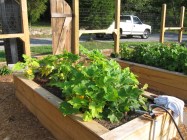

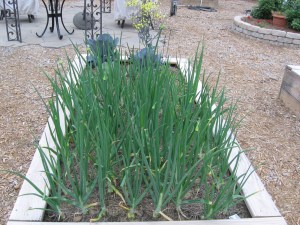
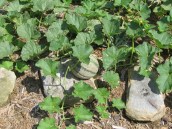
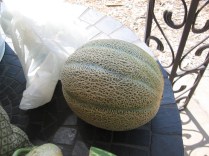
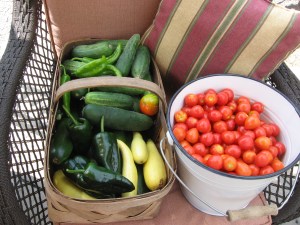
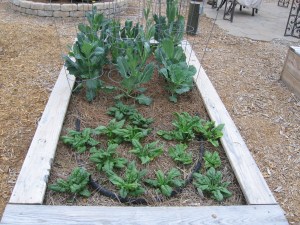
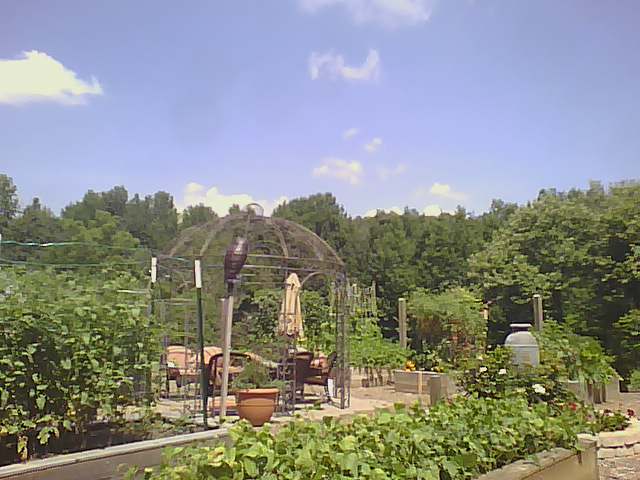


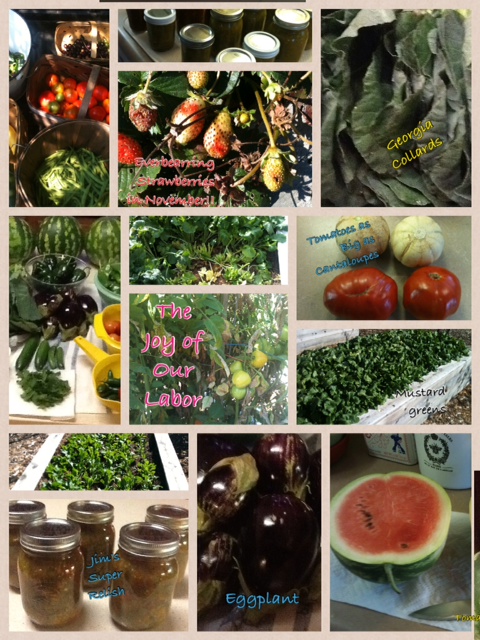
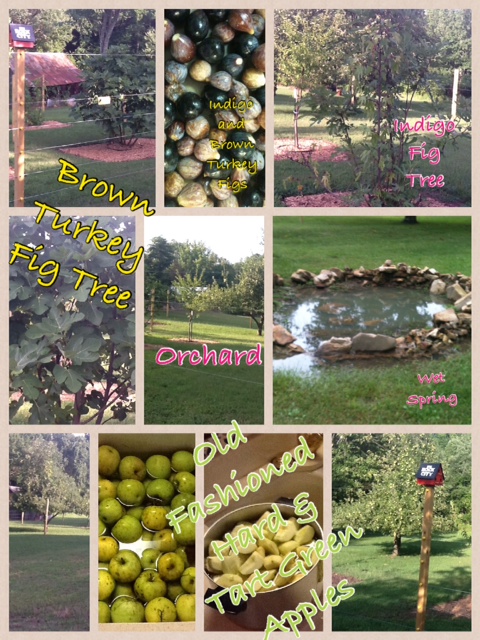










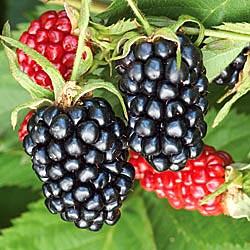

































Hey, Jim, I enjoyed looking at your pictures! It is amazing to me since I can’t even grow tomatoes. Thanks for being so faithful to post.
LikeLike
Joy, so nice to hear from you and pleased that you enjoyed the garden pictures. I am doing so much better physically … Praise The Lord! We love to spend time in the vegetable and flower garden. It draws us back to simpler times and reminds us of where all of our resources come from. God’s creation is amazing … What else can I say?? Jim D.
LikeLike